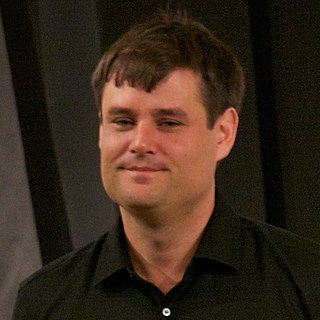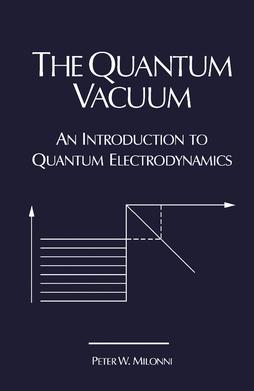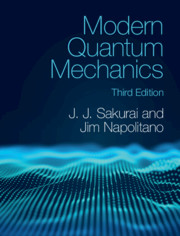
A quantum computer is a computer that exploits quantum mechanical phenomena. At small scales, physical matter exhibits properties of both particles and waves, and quantum computing leverages this behavior using specialized hardware. Classical physics cannot explain the operation of these quantum devices, and a scalable quantum computer could perform some calculations exponentially faster than any modern "classical" computer.
In quantum computing, a qubit or quantum bit is a basic unit of quantum information—the quantum version of the classic binary bit physically realized with a two-state device. A qubit is a two-state quantum-mechanical system, one of the simplest quantum systems displaying the peculiarity of quantum mechanics. Examples include the spin of the electron in which the two levels can be taken as spin up and spin down; or the polarization of a single photon in which the two states can be taken to be the vertical polarization and the horizontal polarization. In a classical system, a bit would have to be in one state or the other. However, quantum mechanics allows the qubit to be in a coherent superposition of both states simultaneously, a property that is fundamental to quantum mechanics and quantum computing.
In quantum physics, a measurement is the testing or manipulation of a physical system to yield a numerical result. The predictions that quantum physics makes are in general probabilistic. The mathematical tools for making predictions about what measurement outcomes may occur were developed during the 20th century and make use of linear algebra and functional analysis.
Quantum information science is a field that combines the principles of quantum mechanics with information science to study the processing, analysis, and transmission of information. It covers both theoretical and experimental aspects of quantum physics, including the limits of what can be achieved with quantum information. The term quantum information theory is sometimes used, but it does not include experimental research and can be confused with a subfield of quantum information science that deals with the processing of quantum information.
The conditional quantum entropy is an entropy measure used in quantum information theory. It is a generalization of the conditional entropy of classical information theory. For a bipartite state , the conditional entropy is written , or , depending on the notation being used for the von Neumann entropy. The quantum conditional entropy was defined in terms of a conditional density operator by Nicolas Cerf and Chris Adami, who showed that quantum conditional entropies can be negative, something that is forbidden in classical physics. The negativity of quantum conditional entropy is a sufficient criterion for quantum non-separability.

Michael Aaron Nielsen is a quantum physicist, science writer, and computer programming researcher living in San Francisco.

Wolfgang Rindler was a physicist working in the field of general relativity where he is known for introducing the term "event horizon", Rindler coordinates, and for the use of spinors in general relativity. An honorary member of the Austrian Academy of Sciences and foreign member of the Accademia delle Scienze di Torino, he was also a prolific textbook author.

Nathaniel David Mermin is a solid-state physicist at Cornell University best known for the eponymous Mermin–Wagner theorem, his application of the term "boojum" to superfluidity, his textbook with Neil Ashcroft on solid-state physics, and for contributions to the foundations of quantum mechanics and quantum information science.

Classical Mechanics is a textbook about that subject written by Herbert Goldstein, a professor at Columbia University. Intended for advanced undergraduate and beginning graduate students, it has been one of the standard references in its subject around the world since its first publication in 1950.
A spin model is a mathematical model used in physics primarily to explain magnetism. Spin models may either be classical or quantum mechanical in nature. Spin models have been studied in quantum field theory as examples of integrable models. Spin models are also used in quantum information theory and computability theory in theoretical computer science. The theory of spin models is a far reaching and unifying topic that cuts across many fields.
In quantum mechanics, a quantum process is a somewhat ambiguous term which usually refers to the time evolution of an (open) quantum system. Under very general assumptions, a quantum process is described by the quantum operation formalism, which is a linear, trace-preserving, and completely positive map from the set of density matrices to itself.

Karl Kraus was a German theoretical physicist who made major contributions to the foundations of quantum physics.

The Quantum Vacuum: An Introduction to Quantum Electrodynamics is a physics textbook authored by Peter W. Milonni in 1993. The book provides a careful and thorough treatment of zero-point energy, spontaneous emission, the Casimir, van der Waals forces, Lamb shift and anomalous magnetic moment of the electron at a level of detail not found in other introductory texts to quantum electrodynamics.

Quantum Computing: A Gentle Introduction is a textbook on quantum computing. It was written by Eleanor Rieffel and Wolfgang Polak, and published in 2011 by the MIT Press.
Quantum Theory: Concepts and Methods is a 1993 quantum physics textbook by Israeli physicist Asher Peres. Well-regarded among the physics community, it is known for unconventional choices of topics to include.

Introduction to Quantum Mechanics, often called Griffiths, is an introductory textbook on quantum mechanics by David J. Griffiths. The book is considered a standard undergraduate textbook in the subject. Originally published by Pearson Education in 1995 with a second edition in 2005, Cambridge University Press (CUP) reprinted the second edition in 2017. In 2018, CUP released a third edition of the book with Darrell F. Schroeter as co-author; this edition is known as Griffiths and Schroeter.

Modern Quantum Mechanics, often called Sakurai or Sakurai and Napolitano, is a standard graduate-level quantum mechanics textbook written originally by J. J. Sakurai and edited by San Fu Tuan in 1985, with later editions coauthored by Jim Napolitano. Sakurai died in 1982 before he could finish the textbook and both the first edition of the book, published in 1985 by Benjamin Cummings, and the revised edition of 1994, published by Addison-Wesley, were edited and completed by Tuan posthumously. The book was updated by Napolitano and released two later editions. The second edition was initially published by Addison-Wesley in 2010 and rereleased as an eBook by Cambridge University Press, who released a third edition in 2020.
This glossary of quantum computing is a list of definitions of terms and concepts used in quantum computing, its sub-disciplines, and related fields.










